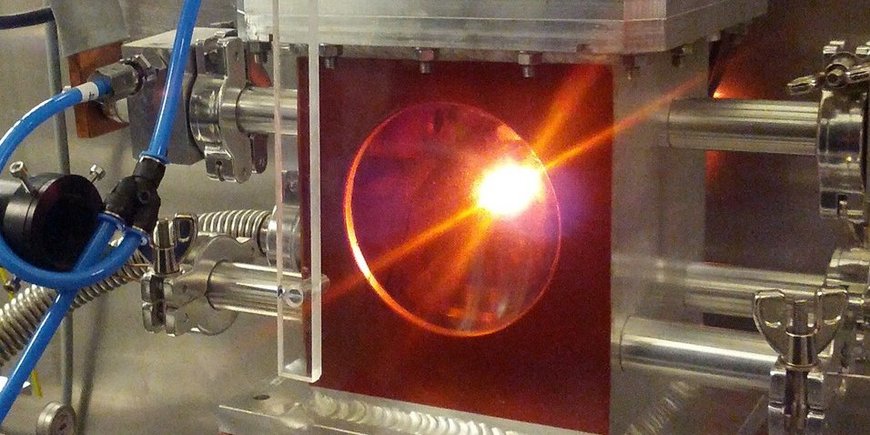Seismic waves propagate over and through the entire globe. From the velocities and deflections of the quake waves, conclusions can be drawn about the nature of the Earth's crust and interior. But some peculiarities have so far puzzled researchers – one of them now seems to have been solved: lab experiments have shown why seismic waves propagate at different speeds in the Earth's mantle. Researchers led by Julia Immor of the Bavarian Geoinstitute at the University of Bayreuth report on this in the journal Nature. Sergio Speziale of the GFZ German Research Centre for Geosciences was involved in the high-pressure experiments.
Crucial to the anomalies in the propagation speed of the waves is a mineral called davemaoite, which until recently was only predicted theoretically and not actually detected until 2021. This mineral, made of calcium and silicon oxide (CaSiO3), forms at a depth of several hundred kilometers under extremely high pressure and at nearly a thousand degrees Celsius. The researchers recreated these conditions using a diamond anvil cell and a graphite furnace just a few millimeters in size and shone a light through the glowing hot sample at the German Electron Synchrotron DESY. It turned out that davemaoite suddenly became very soft.
The researchers thus propose the following scenario in the Earth's interior: When the tectonic plates descend with the crust into the Earth's interior, the thin layer of the Earth's crust that sits on top of the tectonic plates softens considerably. As it continues to descend, the crust can then slip away from the plate, almost like davemaoite becoming a lubricant. The separated crust has different properties than the rest of the mantle. This is the reason for the anomalies in the propagation speed of the seismic waves.
The findings on the mineral davemaoite are significant not least because CaSiO3 makes up a considerable proportion of up to 25 percent in the basaltic ocean crust, depending on depth. Researchers from the Universities of Bayreuth, Oxford and Utah as well as from the GeoForschungsZentrum Potsdam GFZ, the California Institute of Technology and DESY were involved in the study. The project was partly funded by the German Research Foundation DFG.
Original study: J. Immoor, L. Miyagi, H.-P. Liermann, S. Speziale, K. Schulze, J. Buchen, A. Kurnosov, H. Marquardt: Weak Cubic CaSiO3 Perovskite in Earth’s Mantle; in: Nature (DOI: 10.1038/s41586-021-04378-2) Link: https://doi.org/10.1038/s41586-021-04378-2
Scientific contact:
Dr. Sergio Speziale
Scientist
Chemistry and Physics of Earth Materials
Telegrafenberg
14473 Potsdam
Phone: +49 331 288-1848
Mail: sergio.speziale@gfz-potsdam.de








![[Translate to English:] Torsten Sachs in front of a climate station on a field](/fileadmin/_processed_/3/9/csm__TorstenSachs_bearbeitet_GS_4a1365ef84.jpeg)

![[Translate to English:] left image flood at the Ahrtal: image from above, several houses are flooded; left image:: Heidi Kreibich;](/fileadmin/_processed_/4/4/csm_Bild2_9af0130e9f.png)



![[Translate to English:] Start der Vega Rakete](/fileadmin/_processed_/6/4/csm_20231201-kachel_Vega-VV23-launch_ESA-CNES-Arianespace_706716b68c.jpeg)









![[Translate to English:] Poster exhibition at the Brandenburg Hydrogen Day at the GFZ, some participants in the foreground](/fileadmin/_processed_/6/5/csm_Erster_Brandenburgischer_Wasserstofftag_GFZ_402fcec95e.jpeg)
![[Translate to English:] Group picture of the participants](/fileadmin/_processed_/9/4/csm_20231108_CAWa-Workshop-Tashkent_Gruppenbild_99ea779d8a.jpeg)

![[Translate to English:] [Translate to English:] Hörsaal](/fileadmin/_processed_/e/6/csm_H%C3%B6rsal_e21ac645fb.jpeg)


![[Translate to English:] The Delegations in the Historic Library on the Telegrafenberg. In the back there are from left to right, the Dutch Ambassador for Germany, Ronald van Roeden, the Dutch Minister for Education, Culture and Science, Robbert Dijkgraaf and the scientific director of the GFZ, Susanne Buiter.](/fileadmin/_processed_/d/b/csm_Kachel-2_9eba4b4212.jpeg)

